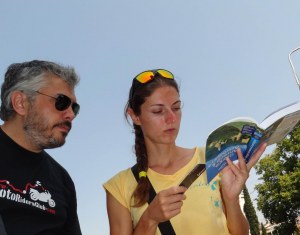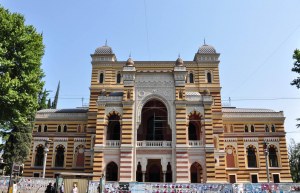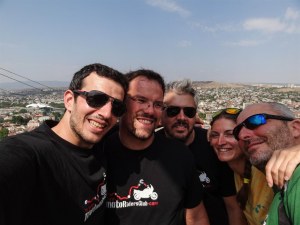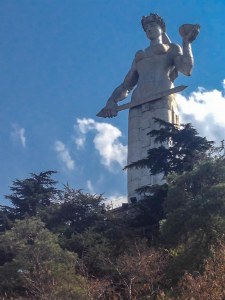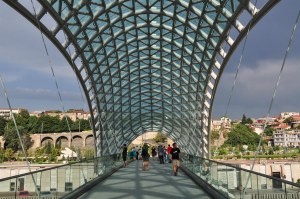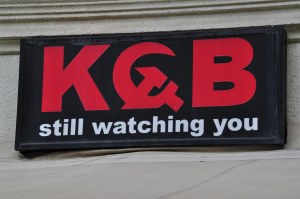Waking finds half of the gang with pains throughout the our bodies. The reason is the layers of the bed which are a must for fakir. Morning stretching, breakfast and departure to see the city. The temperature outside banging red...
The Tbilisi dating from the Neolithic era. The name comes from the Georgian word «tbili» meaning "hot" because of the hot springs in that area. The city was a major trade association of the East -just like was the "Silk Road" - in which collaborated Greek and Roman merchants. Capital of the country was the 1121 by King David. In the 19th century. made many changes in the city - built schools, libraries, theaters - and many immigrants arrived from Germany and Poland. At the end of the 19th century the city had 160,000 inhabitants. The 20th century was difficult, as the city was the center of demonstrations against the Soviet Government. The 21st century but was century of progress and prosperity.
The ride started our Square Philharmonic, hosting the Building of the Georgian culture. It stands out because of the impressive statue depicts a woman holding theatrical masks. A little further we find a second square where the main motif is the statue of the national poet Rustaveli and the impressive building -Stalinist- the Academy of Sciences. On the steps of the academy is an outdoor bazaar with various traditional souvenirs and Soviet memorabilia.
We follow the main street Shota Rustaveli with the tall trees and the impressive massive Soviet-style buildings, which ends at the Freedom Square. The street is home to, among others, the imposing Opera House, the Theater and the Parliament, which has one of the most ornate facades of the city, built between 1938 and 1953. For 1989, 20 Georgian protesters killed by Russian soldiers.
Opposite the Parliament is the Kashveti church which previously were pagan ceremonies. It was built by a Syrian priest and according to legend, a nun accused that left her pregnant. He replied that if this were true it would give birth baby, if not we will give birth to a stone, which he did. The word «Kashveti» means "stone birth."
Just below is the National Museum of Georgia, which we visited (entry level: 2Lari). It features permanent and seasonal exhibits, while prominently exposed a skull dating from 4500BC. The collection of gold jewelery and works of art of the pre-Christian Georgia and exhibits relating to the period of Soviet occupation is quite interesting.
Continuing walking, soon we arrive at Freedom Square. In the center stands the golden statue of St. George surrounded by majestic buildings. On the south side of the square starts the old city of Tbilisi. The cobbled streets and old buildings mark the limits of the area which had previously inhabited mainly by Armenians. As we snuggle through the narrow streets, we are being amaged by the two and three storey traditional houses. Unfortunately, the area is not well maintained, and most buildings is Laid to their fate, crumbling and almost derelict, which prevents you admire their architecture. The only thing you left is to imagine that these neighborhoods will look like in their good times.
Following the signs for «Mother of Georgia», climb about 400 steps to find ourselves at the top of the hill there is the impressive statue of Mother Georgia. The Kartlis Deda (Mother Georgia) was built in the 60's and is the symbol of the city. It shows a woman in one hand holding a sword and the other a glass of wine. With the notation that wants to highlight the Georgian character, who warmly welcomed the guests and battling enemies with passion.
The same point is the Narikala fortress dating from the 4th century and is the ancient symbol of the city defense. The walls date from various periods. The tower and most of the walls were built by order Arab Emirates in the 8th century. Georgians, Turks and Persians contributed to building it, but in 1827 a large explosion in Russian ammunition, which was stored here, destroyed the fortress and the church of St. Nicholas was inside. The church was rebuilt recently. The point is accessible via cable car, for those who want to avoid stairs and offers a stunning panoramic view of the city and the river Mtkvari which crosses.
Moving around the walls, go down in the area Abanotubani, the thermal baths (sulfur) in the city. In this region there are many underground baths (hammam type) and is among the most well-maintained areas of the old city. There is also the only mosque in the city, and the rest destroyed during religious "purifications" in 1930.
We make a short stop for the necessary "katsapouri" (=pie with cheese) of the day and continue for the park, which leads and the cable car. The park has a recent renovation marks (or creation) and presents a more modern character with trails, parks for children, fountains, outdoor chess boards and various tubular structures, while many of the projects are not yet completed.
A little further we find the Bridge of Peace. A futuristic bridge, 150m long, which was built in 2010 over the river Mtkvari in order to unite the old with the new city. The ultramodern design does not like much the locals who call it "Always", named after the napkin, because they claim that their reminds. And not wrong... The cross to find ourselves in the unique -almost- tidy pedestrian old town, which is full of coffee houses and restaurants, showing a different face of the region. Maybe if this picture is extended to the remaining part, to show the real charm and beauty of the old city.
The time has rolled on the good and the fatigue has the appearance of long ago. This was helped by the unbearable heat that prevailed in conjunction with crazy exhaust. So we take the way back on board, watching interesting touches of the city...
Near the house there isn't a restaurant that has opened our interest, when combined with the fatigue, the best solution is yesterday. That is to eat home... We are entering a large supermarket to get some supplies, and observe that features local cuisine and cooked food. Provided with "that pulls our soul" and lay the table together natural topical 5 liter beer. Of course the focus of the conversation is all we saw today in the city and admittedly Tbilisi not impressed us as we would expect...
Apart from these, our mind is the next day ... which will be our first in Armenia ...






